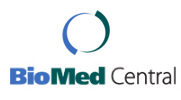Scoliosis

ORAL PRESENTATION
Open Access
Oral presentation
SpineCor treatment for adolescent idiopathic scoliosis - 5 years follow-up after weaning of the brace
AB Circo*, C Coillard and CHI Rivard
Address: Research center, Sainte-Justine Hospital & University of Montreal, 3175 ch. Cote ste-Catherine, Montreal, Quebec, H3T IC5, Canada
Email: AB Circo* altn_circo@yahoo.ca
• Corresponding author
from 6th Internationl Conference on Conservative Management of Spinal Deformities
Lyon. France. 21-23 May 2009
Published: 14 December 2009
Scoliosis, 2009. 4(Suppl 2):055 doi:10.1186/1748-7161-4-S2-055
This abstract is available from http://www.scoliosisjournal.com/content/4/S2/055
© 2009 Circo et al: license BioMed Central Ltd.
Objective
Knowing that any apparent correction of a scoliosis curve that occurs during rigid brace treatment for adolescent idiopathic scoliosis (AIS) can be expected to be lost over time, the purpose of this prospective intervention study was to evaluate the stability of the spine 5 years after the weaning point of the SpineCor brace.
Study design
From 1993 to 2009, 840 patienit were treated for MS using the SpineCor brace. 495 fated patients had a definitive outcome, and 405 patients finished the treatment with the SpineCor brace. 94 patients had at least 5 years of followup. The assessment of brace effectiveness included the following: percentage of patients who had a 5° or less curve progression and the percentage of patients who had 6° or more progression; percentage of patients who have been recommended for or have undergone surgery before skeletal maturity; percentage of patients with curves exceeding 45° at maturity (end of treatment); 2-years follow-up beyond maturity to determine the percentage of patients who subsequently underwent surgery; percentage of patients that corrected or stabilized their Cobb angle 5 years after the weaning point.
Results
Looking at the stability of the curves after the end of the treatment, 29% of the patients still continued their correction after the weaning point, 63.5% remained stable, and
only 7.5% progressed by more than 5' (4.3% of them had a surgery recommendation after the weaning point).
Conclusion
Conclusion the SpineCor brace is effective for the treatment of adolescent idiopathic scoliosis. Positive outcomes are maintained 5 years after the weaning of the brace. Moreover, one third of the patients still maintained correction of their Cobb angle in the five-year period after the end of the treatment.
Please contact our office for a complimentary Xray review consultation to see if our scoliosis treatment and scoliosis soft bracing is a good fit for your child.

Chiropractor Supervised

Scoliosis Colorado
9137 S Ridgeline Blvd Suite 260
Highlands Ranch, CO 80129
Phone: 303-683-5155
**Pinnacle Chiropractic stood out amongst its competitors by winning the first place title for the 10th year. Dr. Casselman, DC and Pinnacle Chiropractic won the coveted best chiropractor award, which falls under the medical category of the competition. Each year area residents vote by mail or online for their favorite local businesses. The votes are tallied by the Colorado Community Media and include 24 of Colorado’s local communities. The business with the most votes in each category is named the Best of the Best for that specific category for that town. The Colorado Community Media is a collaborative project between Mile High Newspapers, Community Media of Colorado and MetroNorth Newspapers.
© Scoliosis Colorado.
Terms of Use | Privacy Policy | Disclaimer | Medical Disclaimer

